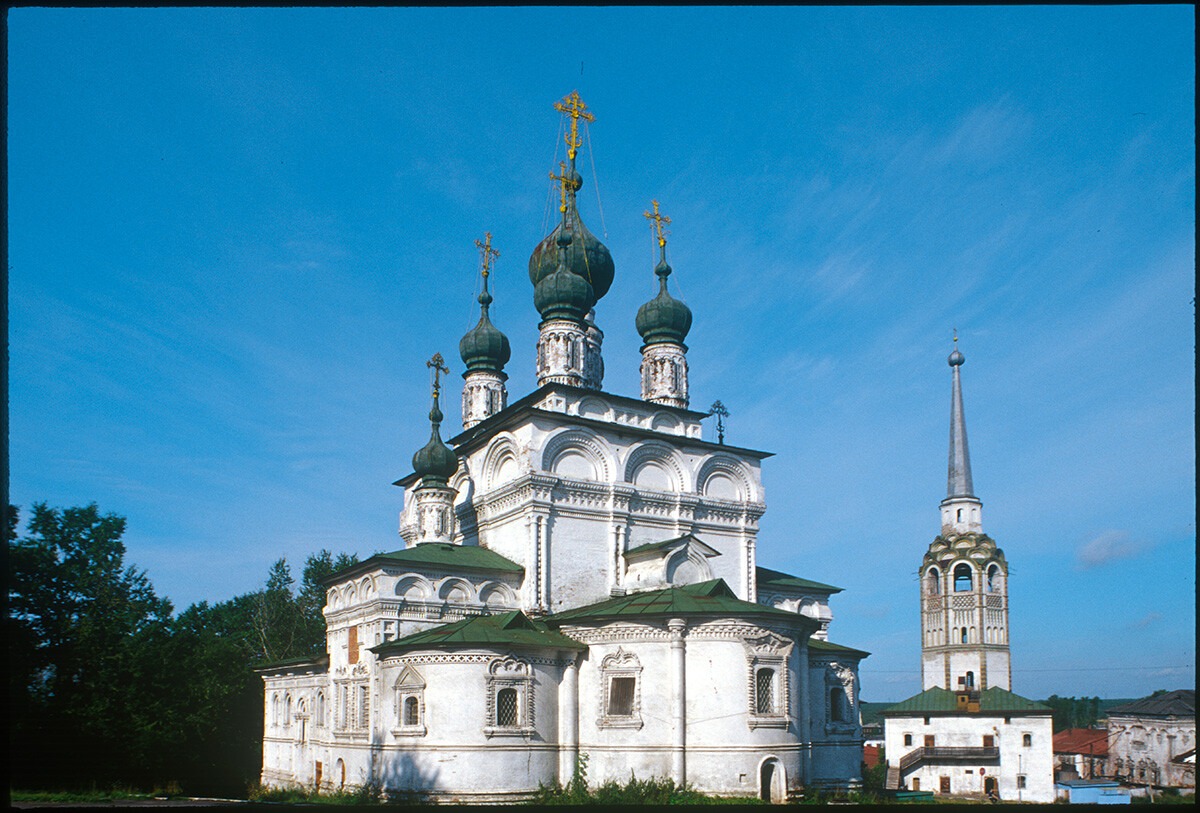
Solikamsk. Cathedral of the Trinity, northeast view. Right: Cathedral bell tower. August 24, 1999
William BrumfieldAt the beginning of the 20th century, Russian chemist and photographer Sergey Prokudin-Gorsky developed a complex process for vivid, detailed color photography. His vision of photography as a form of education and enlightenment was demonstrated with special clarity through his photographs of architectural monuments in the historic sites throughout the Russian heartland.
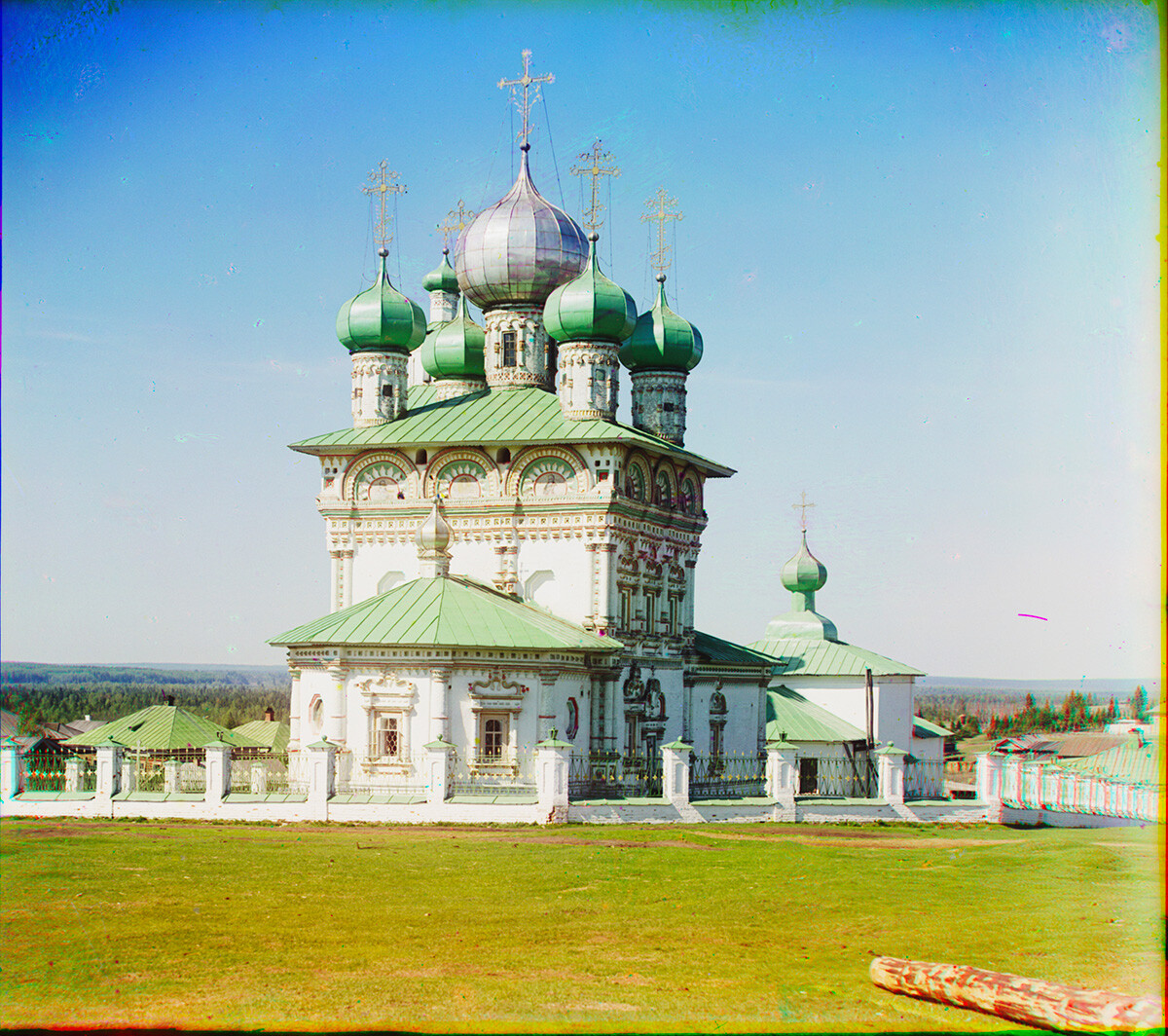
Nyrob. Church of St. Nicholas, northeast view. Photo: 1913. Circa 1907
Sergey Prokudin-GorskyProkudin-Gorsky's visit to the northern Urals, which took place presumably in the Spring of 1913, in connection with the 300th anniversary of the Romanov dynasty, included the town of Cherdyn and the small settlement of Nyrob, which had direct connections with the history of the Romanov dynasty. The photographer was personally acquainted with Nicholas II and would have gladly undertaken a project on his behalf.
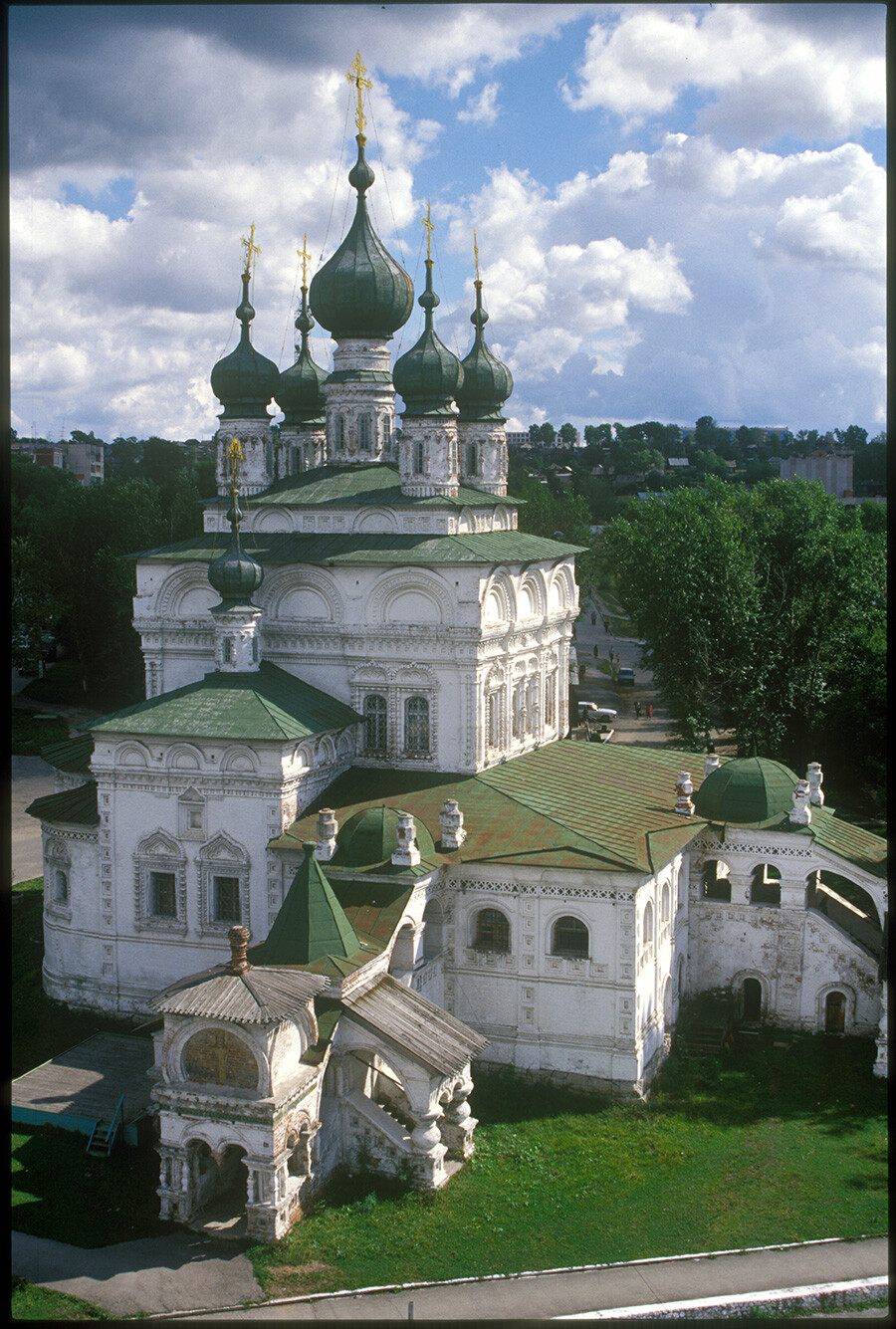
Solikamsk. Cathedral of the Trinity, northwest view from cathedral bell tower. August 11, 2000
William BrumfieldAlthough Prokudin-Gorsky took several photographs of these remote areas, he left no record of a visit to Solikamsk, a larger historic town in the same area, which he probably passed through on his way north to Cherdyn. In any event, Solikamsk has one of the most impressive ensembles of historic architecture in the entire vast Perm territory.
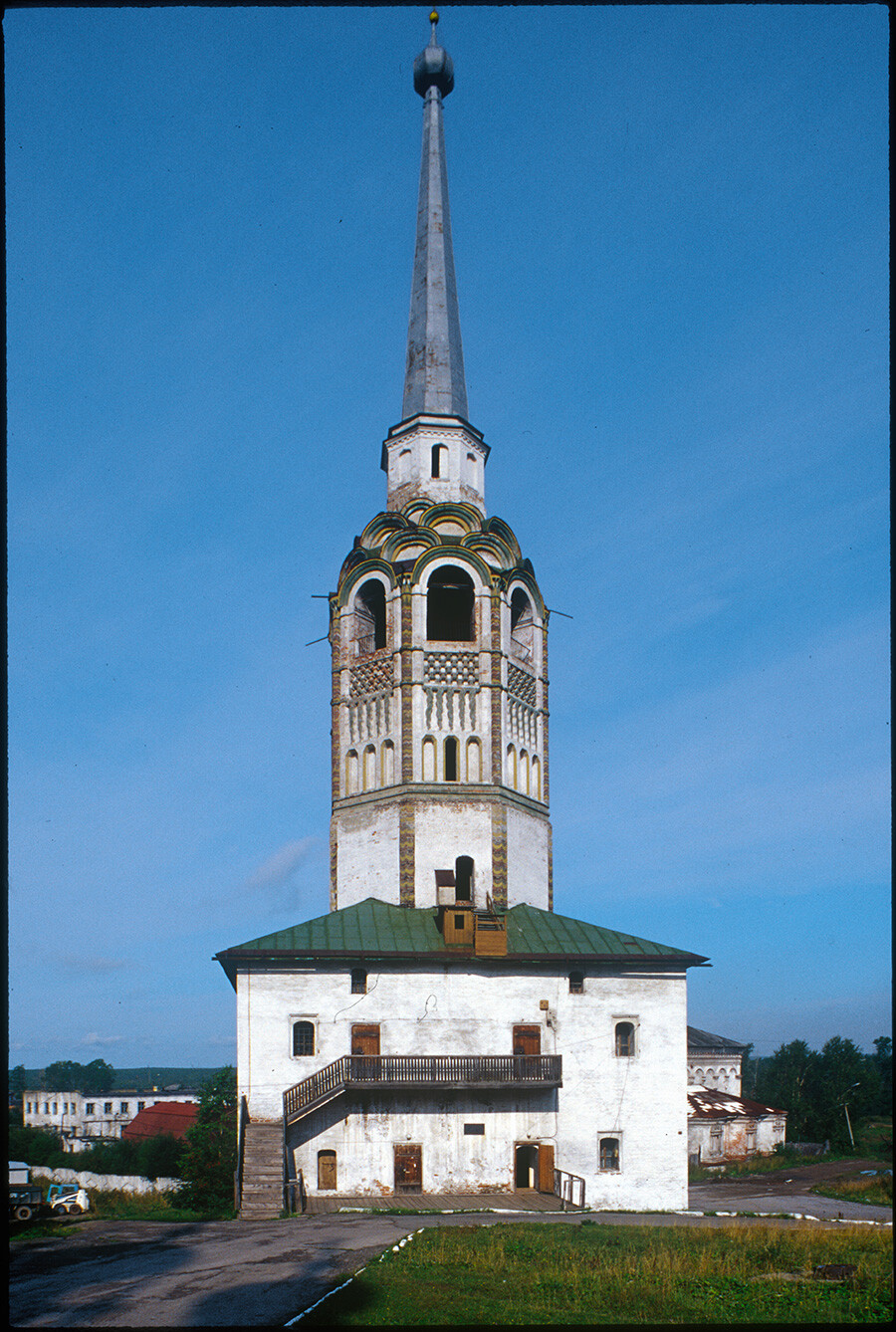
Solikamsk. Cathedral bell tower. south view. August 24, 1999
William BrumfieldLocated near the Kama River some 370 kilometers north of the city of Perm, Solikamsk was founded in 1430, when the Kalinnikov merchant family (from Vologda in the Russian north) established a salt works there. Indeed, the town’s name means "salt on the Kama".
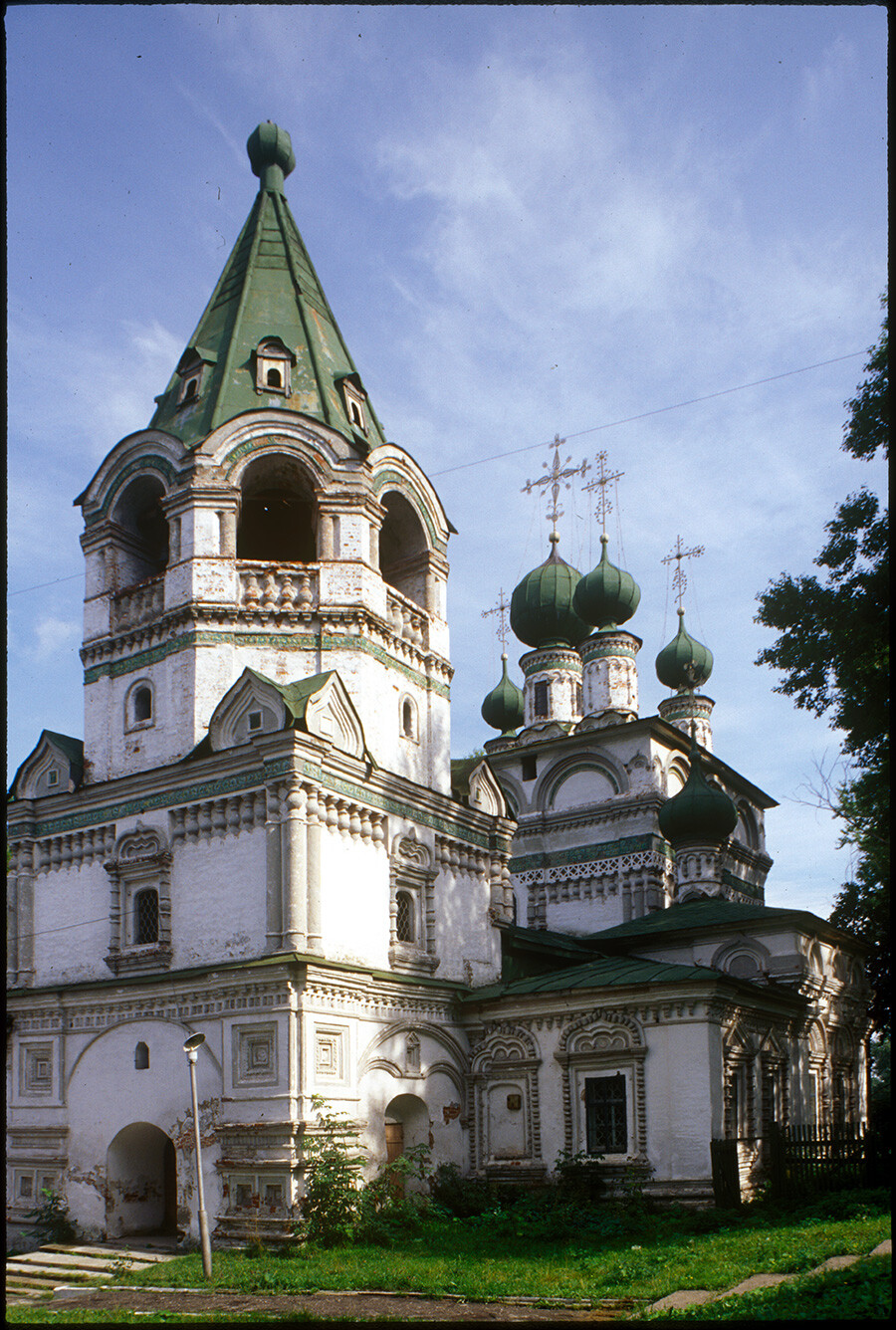
Solikamsk. Church of the Epiphany, southwest view. August 24, 1999
William BrumfieldTo this day, the economy of Solikamsk (current population around 110,000) depends heavily on the mining of potassium and related salts. By the end of the 17th century, Solikamsk also served as a major transit point not only to Siberia, but also for trade with China.
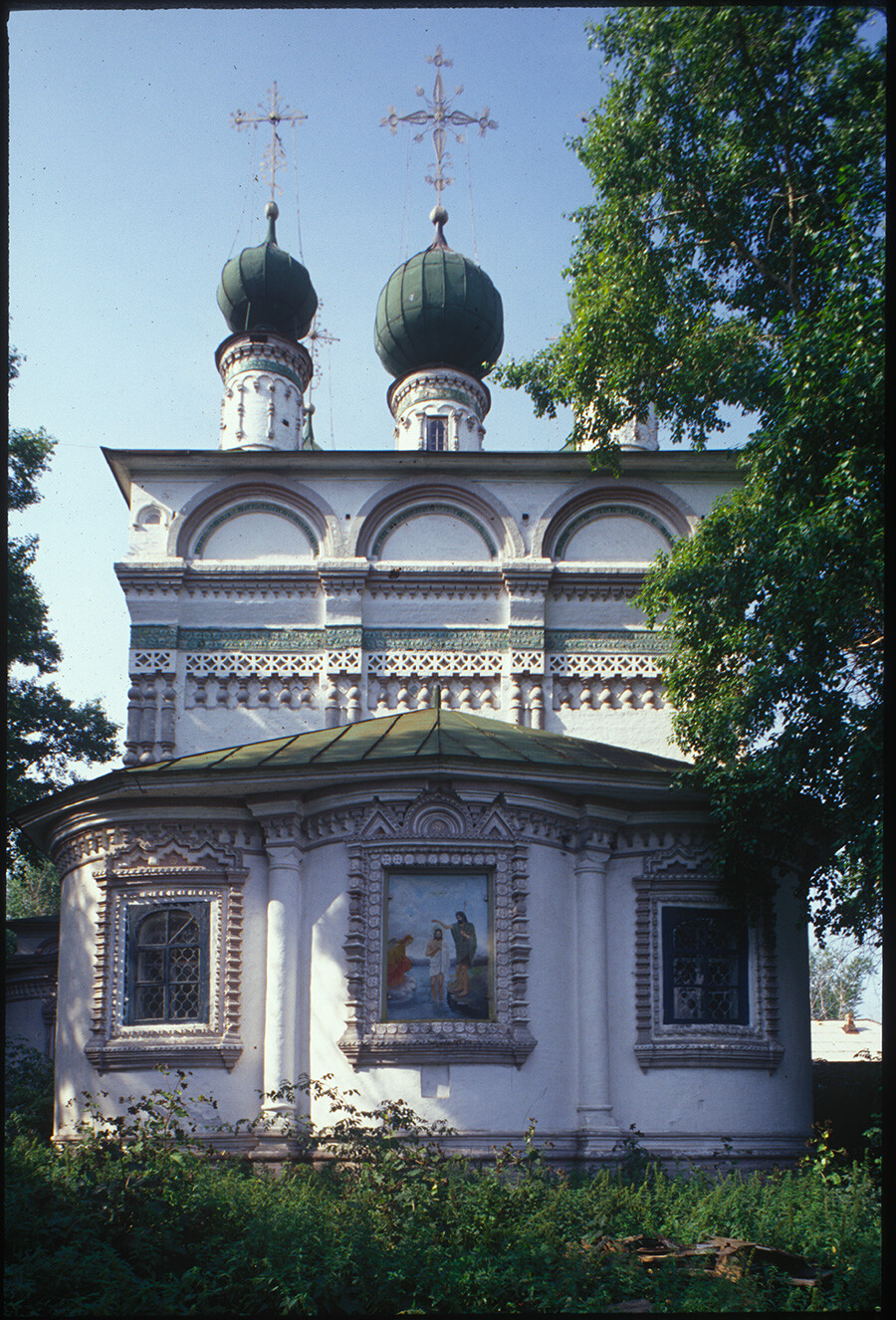
Solikamsk. Church of the Epiphany. East view with paintings on apse walls. August 24, 1999
William BrumfieldThe combination of salt refining, administration, and transportation of goods to market created the economic base necessary for major construction in Solikamsk, particularly of churches.
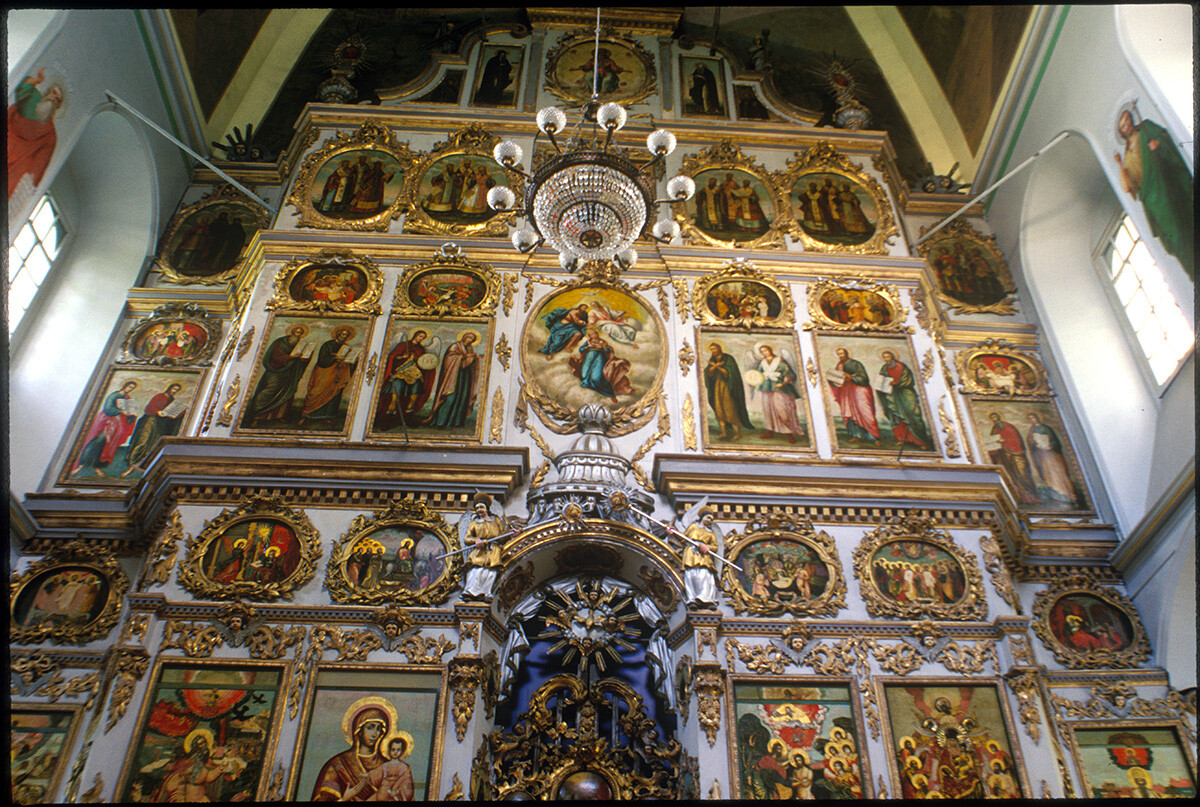
Church of the Epiphany. Icon screen. August 24, 1999
William BrumfieldDespite severe losses suffered during the decades-long Soviet suppression of religion, Solikamsk has preserved many of the buildings of its historic center.
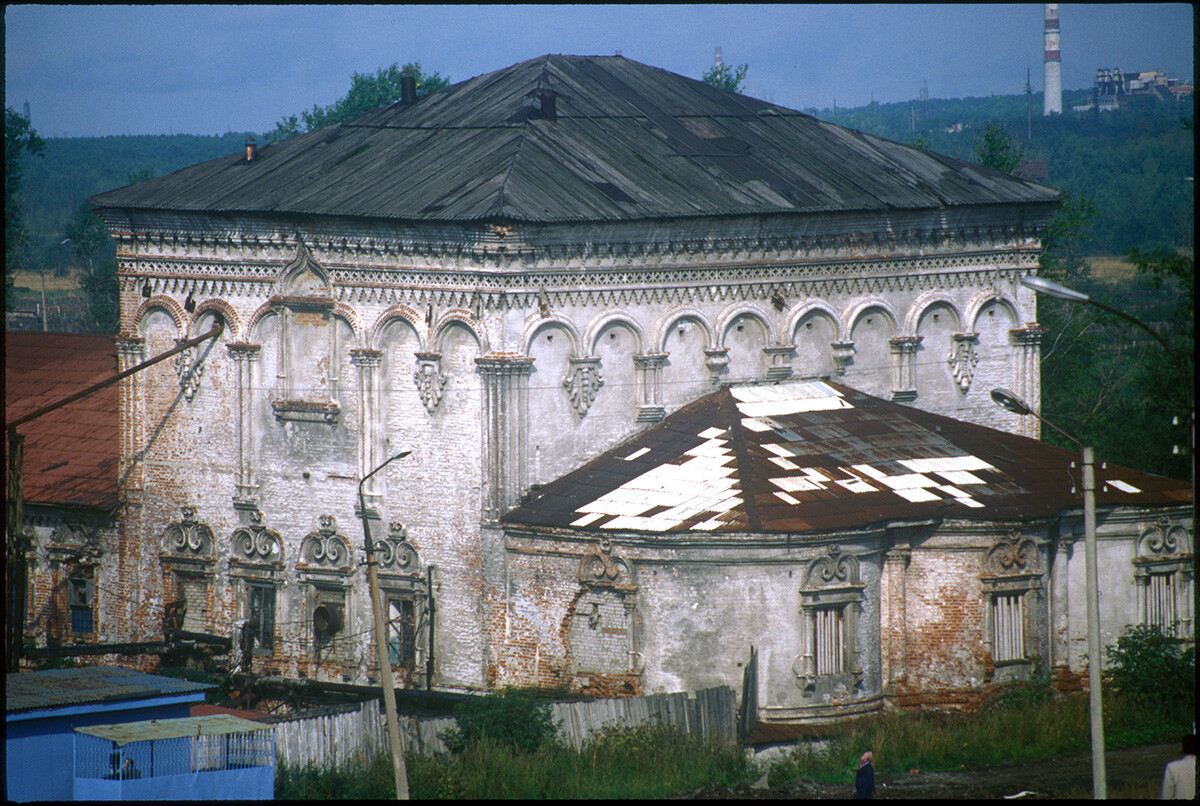
Church of the Elevation of the Cross, southeast view with elaborate facade decoration. August 24, 1999
William BrumfieldThese and other architectural monuments are all within walking distance of the main market square, which to this day defines the town center.
The primary monument of religious architecture in Solikamsk is the late 17th-century Trinity Cathedral, with its adjacent 60-meter bell tower and spire that looks like some odd transplant from St. Petersburg--as well it might, due to its construction in 1713.
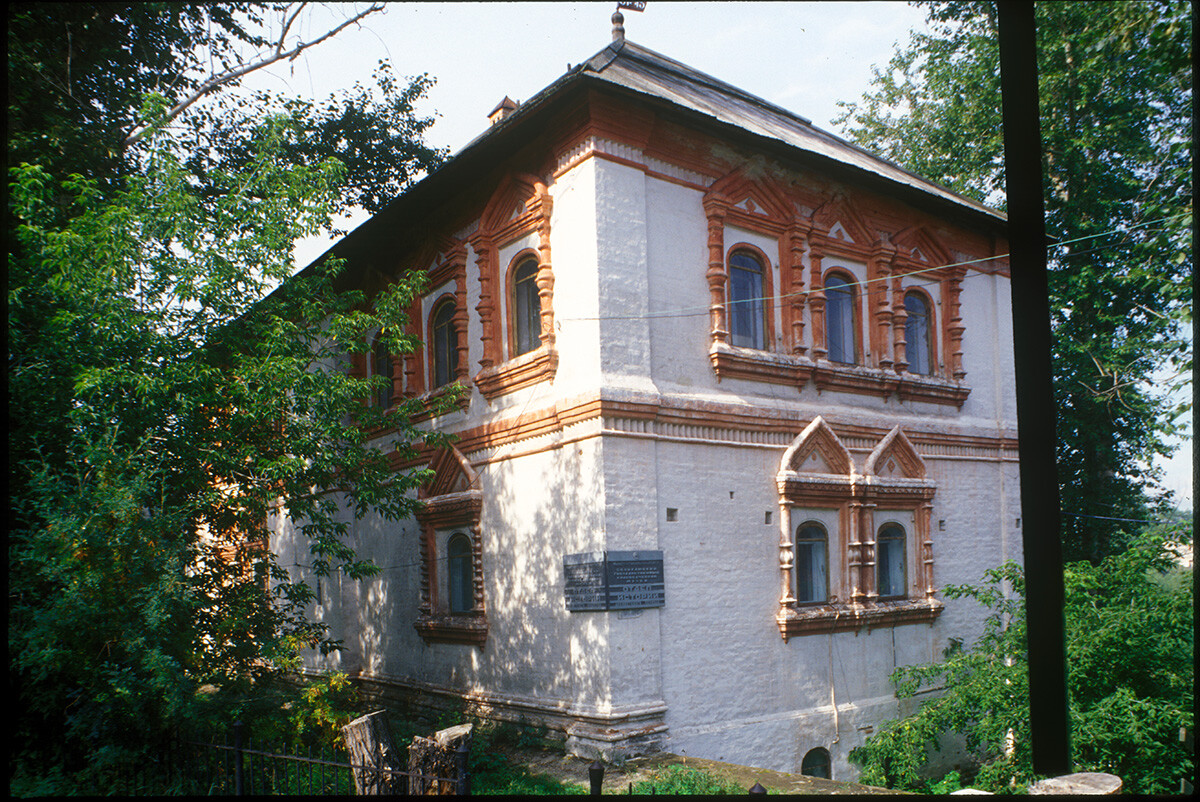
House of the Voevoda, southeast view. Built between 1673--88, this administrative office is the oldest surviving masonry building in the Urals. Second floor added in early 18th century. August 24, 1999
William BrumfieldNot far from Trinity Cathedral is the picturesque Epiphany Church with its colorful ceramic tile decoration. The interior has a superb early 19th-century icon screen miraculously intact.
The fourth major element of the central ensemble in Solikamsk was the Cathedral of the Elevation of the Cross, begun in 1698 and consecrated in 1709. From its location on the left bank of the Usolka River, this church anchored the view of Solikamsk from the west. Simple in plan and unusually broad in proportions, the church had one large cupola, originally covered with wooden shingles. During the Soviet period, when the building was converted into a brewery, all elements above the roof were removed.
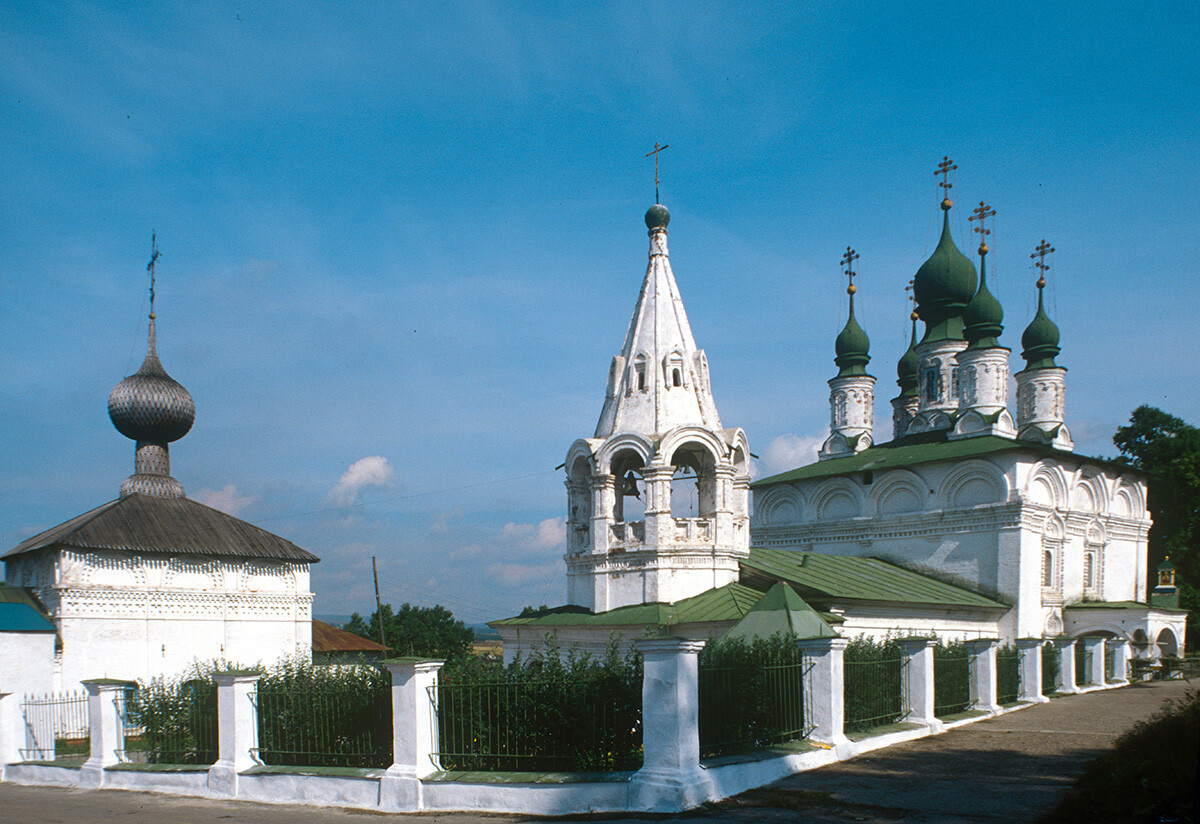
Transfiguration Convent. Left: Church of the Presentation, south facade. Right: Bell tower & Church of the Transfiguration, southwest view. August 24, 1999
William BrumfieldThere are other churches and monasteries in Solikamsk, most of which are grouped within easy walking distance to the central market square. The extraordinary architectural ensemble at the center of Solikamsk forms one component of a creative surge at the end of the 17th and the beginning of the 18th centuries.
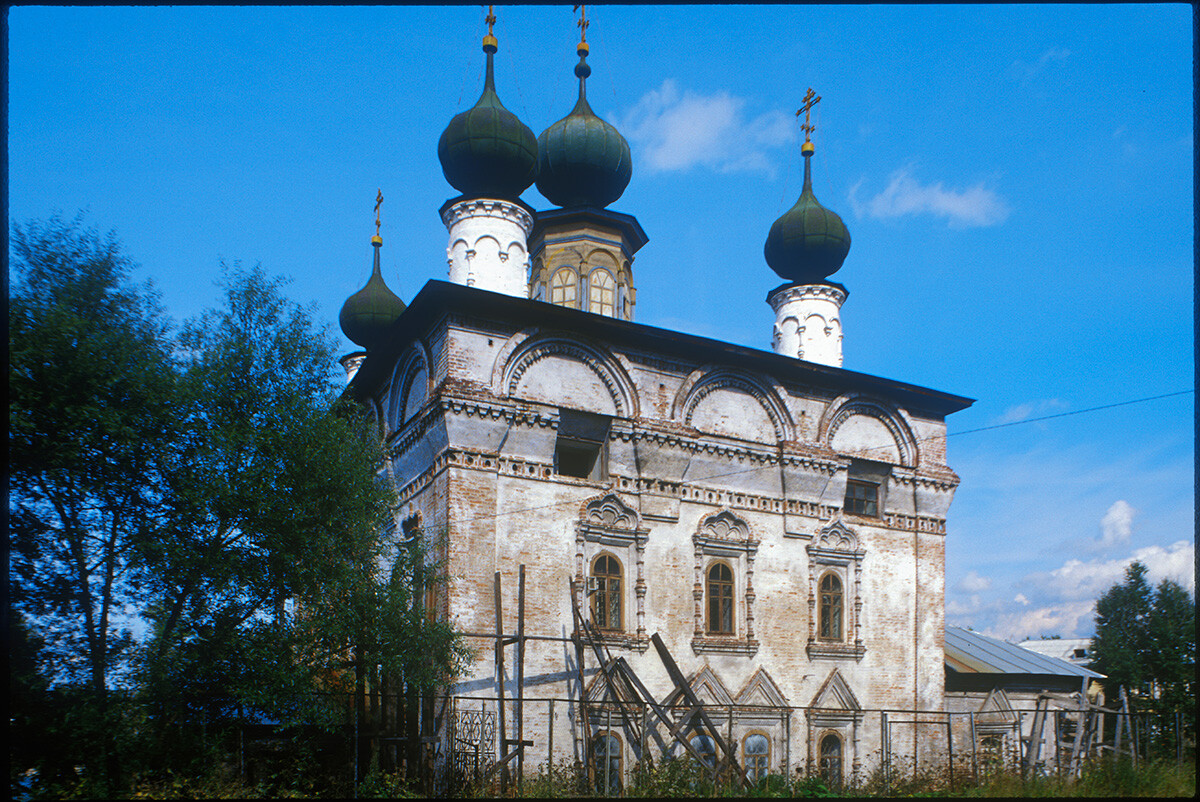
Church of the Miraculous Image of the Savior, south view. August 24, 1999
William BrumfieldSome 200 meters to the east of the central ensemble stands the Transfiguration Convent, endowed in 1683 by Evdokia Shchepotkina, the widow of a Moscow merchant who had enriched himself through trade with Solikamsk. Despite its endowment, the convent was poor, and contemporary accounts note that it had no fields of its own or fishing rights.
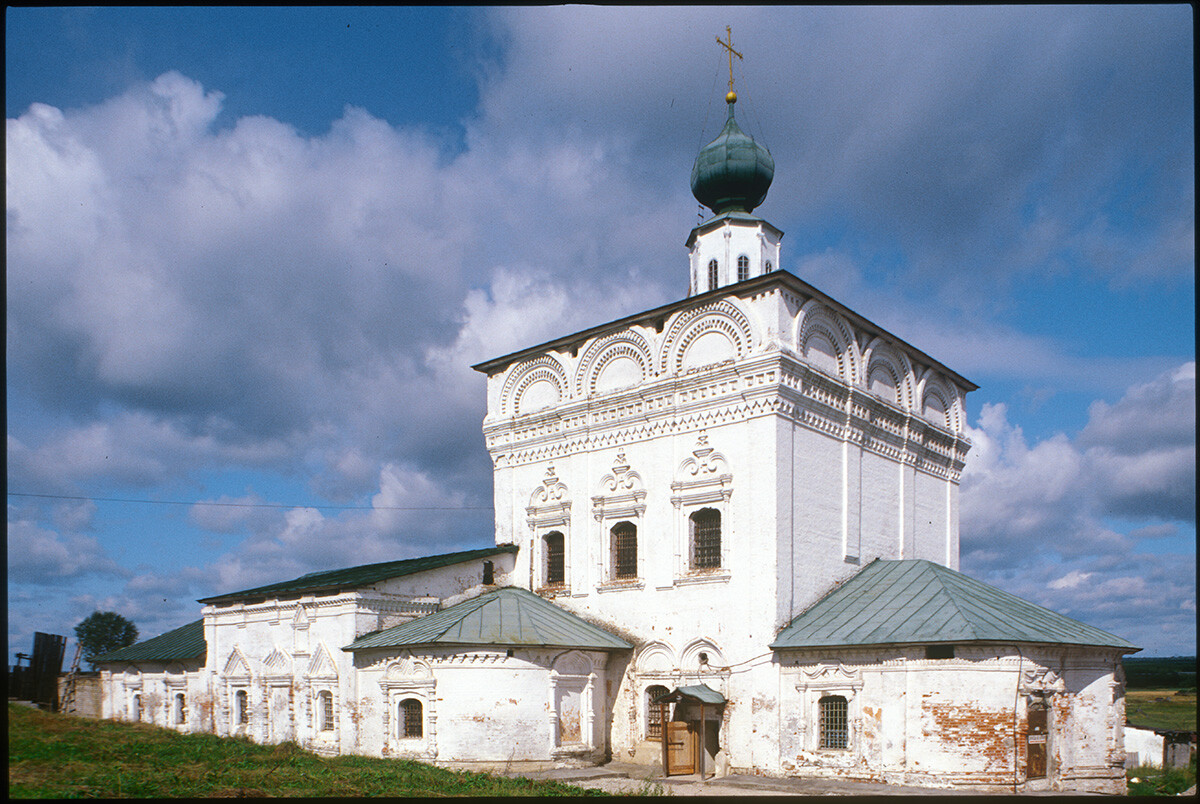
Church of the Ascension (Trinity), Ascension-Trinity Monastery. Southeast view. August 12, 2000
William BrumfieldFor daily support the Transfiguration Convent depended on alms gathered by the nuns, who lived in modest log dwellings typical of the central area of Solikamsk. Nonetheless, from its inception the convent was endowed with a pair of brick churches, one for use in winter and the other a "summer" church.
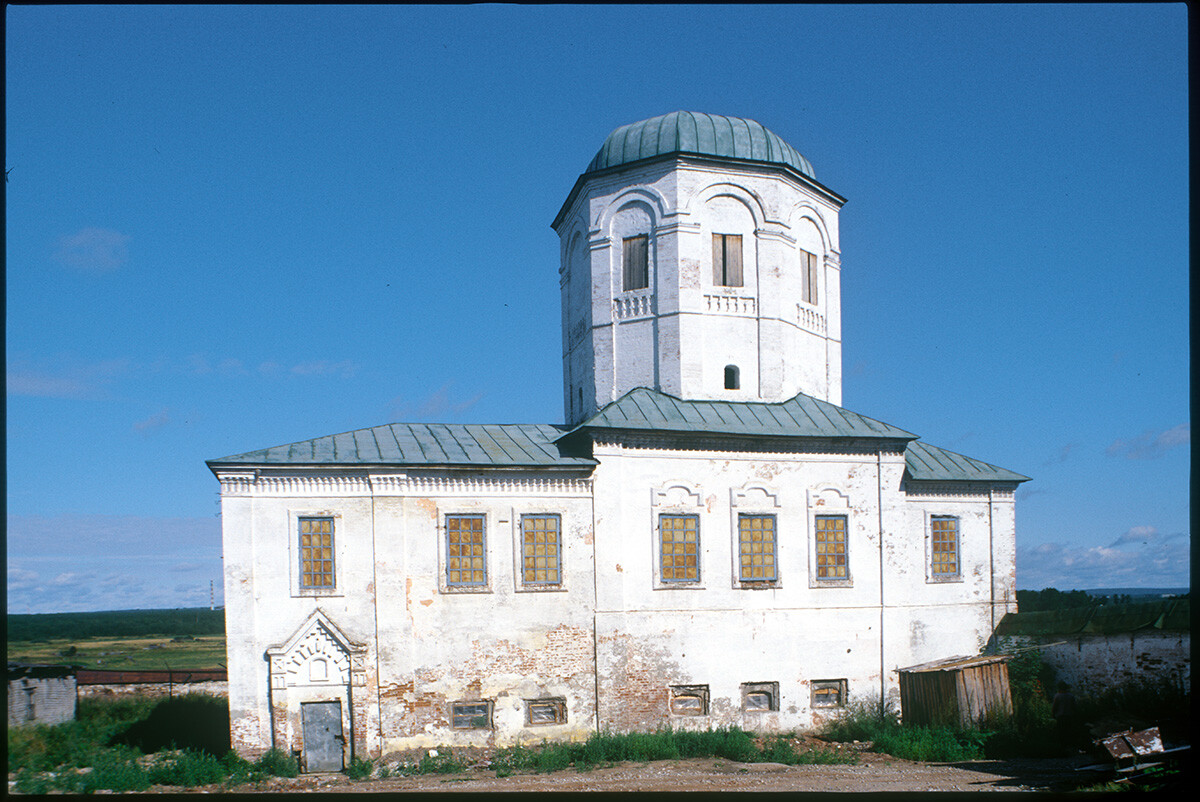
Church of St. Michael Malein, Ascension-Trinity Monastery. August 12, 2000
William BrumfieldThe opposite, western end of Solikamsk is marked by the Monastery of the Ascension-Trinity, which existed as early as the second half of the sixteenth century. Rebuilt in 1608, the monastery consisted of wooden buildings until the end of the seventeenth century, when work began on the Church of the Ascension (now the Trinity Cathedral). Built in 1698-1704 with support from the Surovtsev merchant family, this distinctive masterpiece has one cupola and a simple roof above a white-walled structure that is among the most richly decorated in Solikamsk.
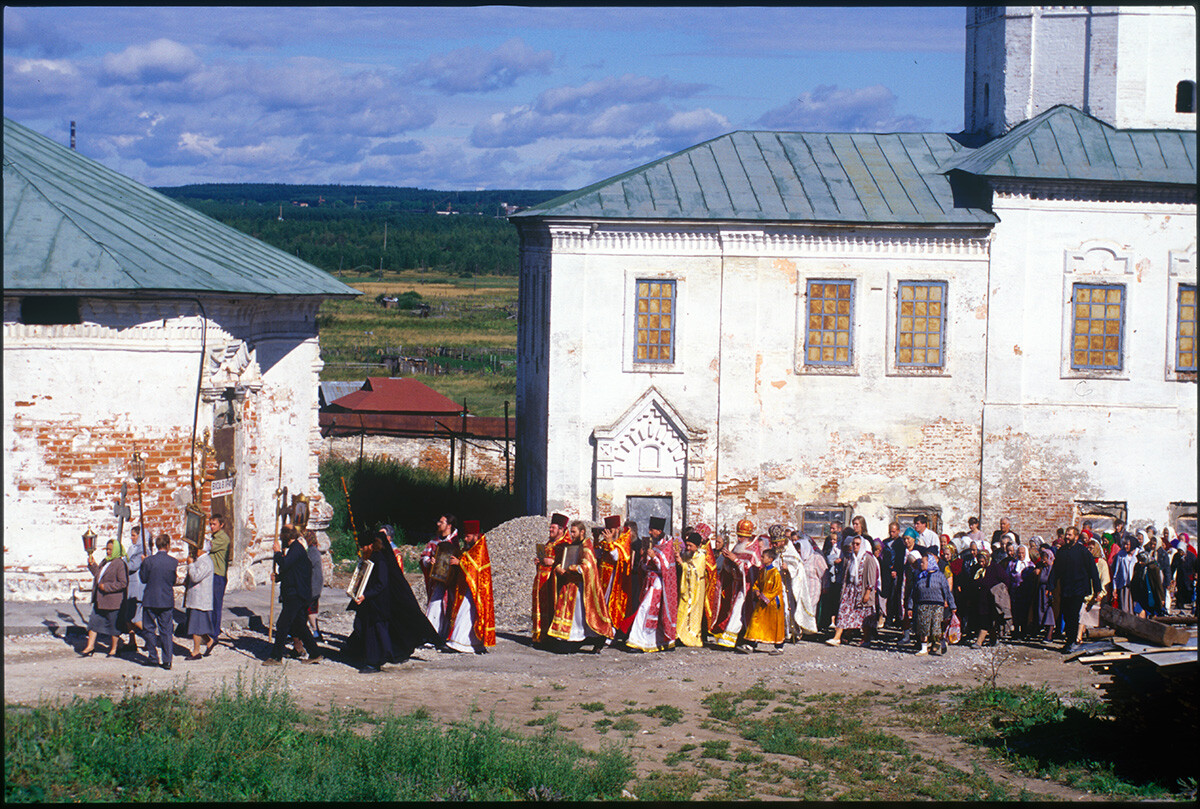
Ascension-Trinity Monastery. Historic photograph of Procession of the Cross from Church of St. Michael Malein to reconsecrate Church of Ascension/Trinity (left) which had been used as prison from 1938. August 12, 2000
William BrumfieldA second masonry church in the Ascension Monastery was built in 1731-1734 and dedicated to Saint Michael Malein (now Ascension). Austere in its decoration, the church flanks the main (east) gate to the monastery and served as the base for the monastery bell tower.
In 1764 the Ascension Monastery was closed as economically unsustainable under Catherine the Great’s monastic reforms, and the premises remained unused for several years. In 1795 a monastic transfer led to its rededication as the Trinity Monastery, and services resumed.
Closed in the late 1920s, the Ascension-Trinity monastery was transferred in 1938 to the NKVD for use as a prison within Usollag, part of the Gulag system. Restoration work began on the damaged shrines in the late 1980s, and in 1999 the monastery was returned to the Orthodox Church for active use.
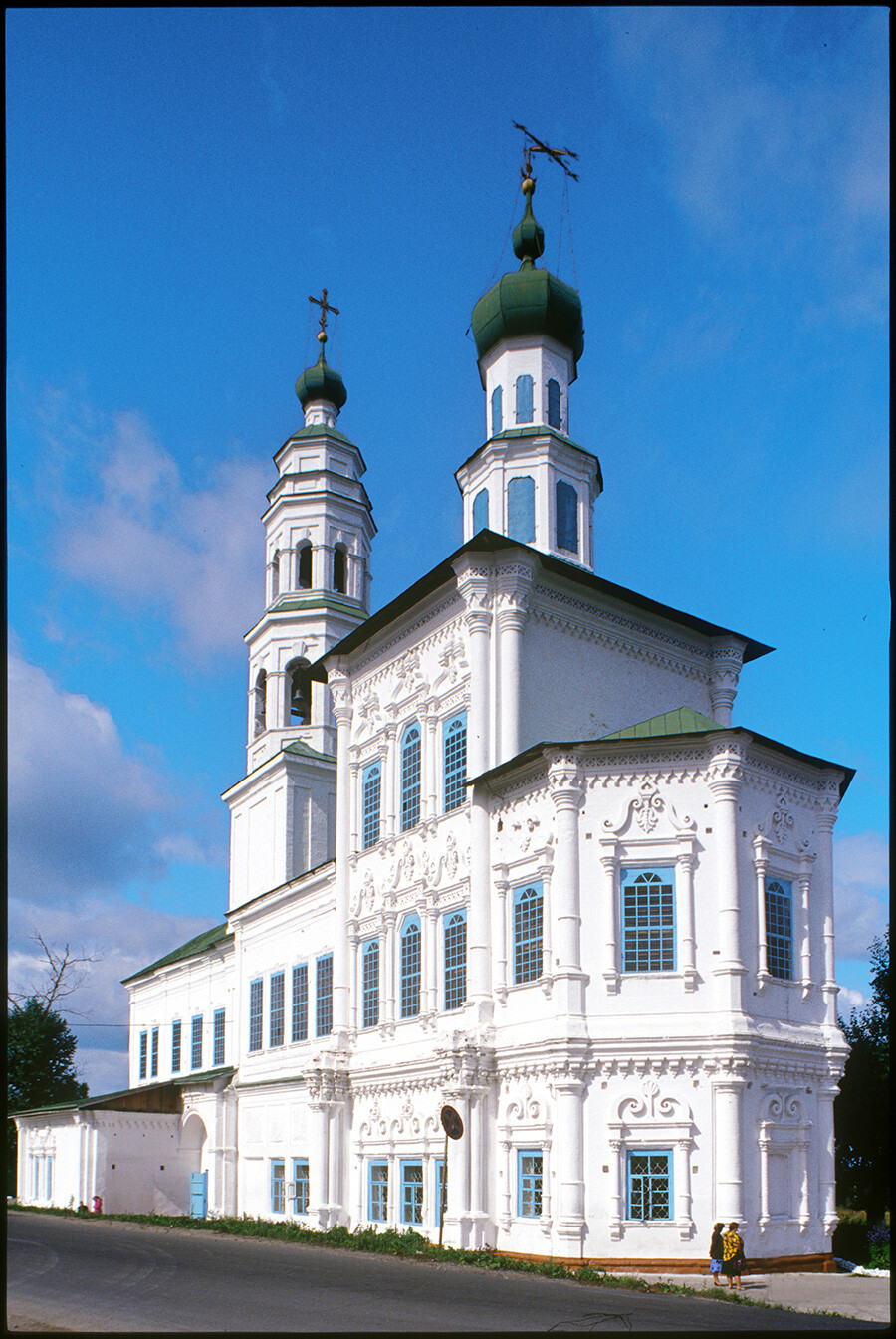
Church of Nativity of John the Baptist, southeast view. August 12, 2000
William BrumfieldThe farthest architectural dominant on the western fringes of Solikamsk is the Church of John the Baptist, situated in what was formerly known as the village of Krasnoe. Located near the banks of the Usolka, the soaring forms of the church and its six-tiered bell tower could be seen from the Kama River, and thus served as a beacon for boats headed toward Solikamsk via the Usolka River.
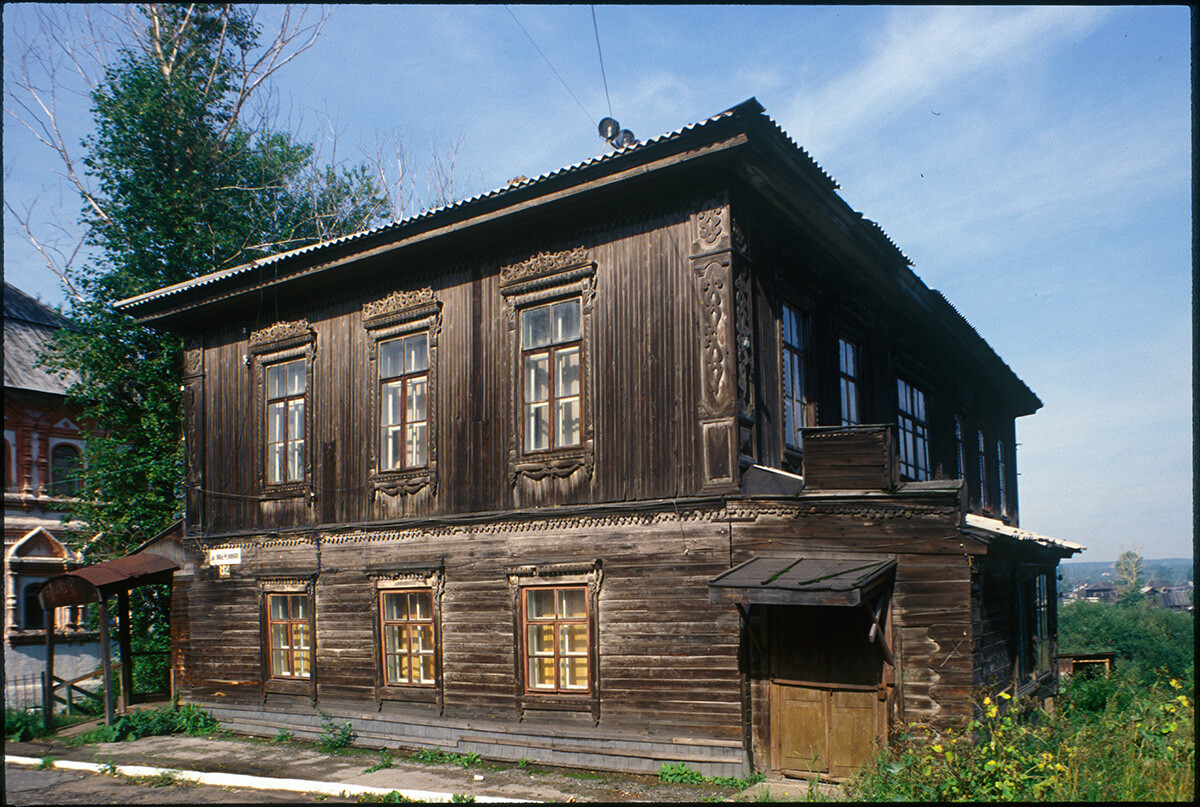
Wooden house (late 19th century), Embankment Street 82. Left: House of the Voevoda. August 24, 1999
William BrumfieldThe tall forms of the Church of John the Baptist arose in two stages. The first stage, the "lower temple" dedicated to John the Baptist, was begun in 1715 and completed in 1721 with the support of a donation by the salt merchant Ivan Surovtsev. The upper church, dedicated to Saint John the Warrior, was completed in 1772 with a donation by Count Aleksei Turchaninov, who owned the village of Krasnoe as well as a large copper smelting factory. The facades of the Church of John the Baptist display the decorative flourishes typical of the Solikamsk style.
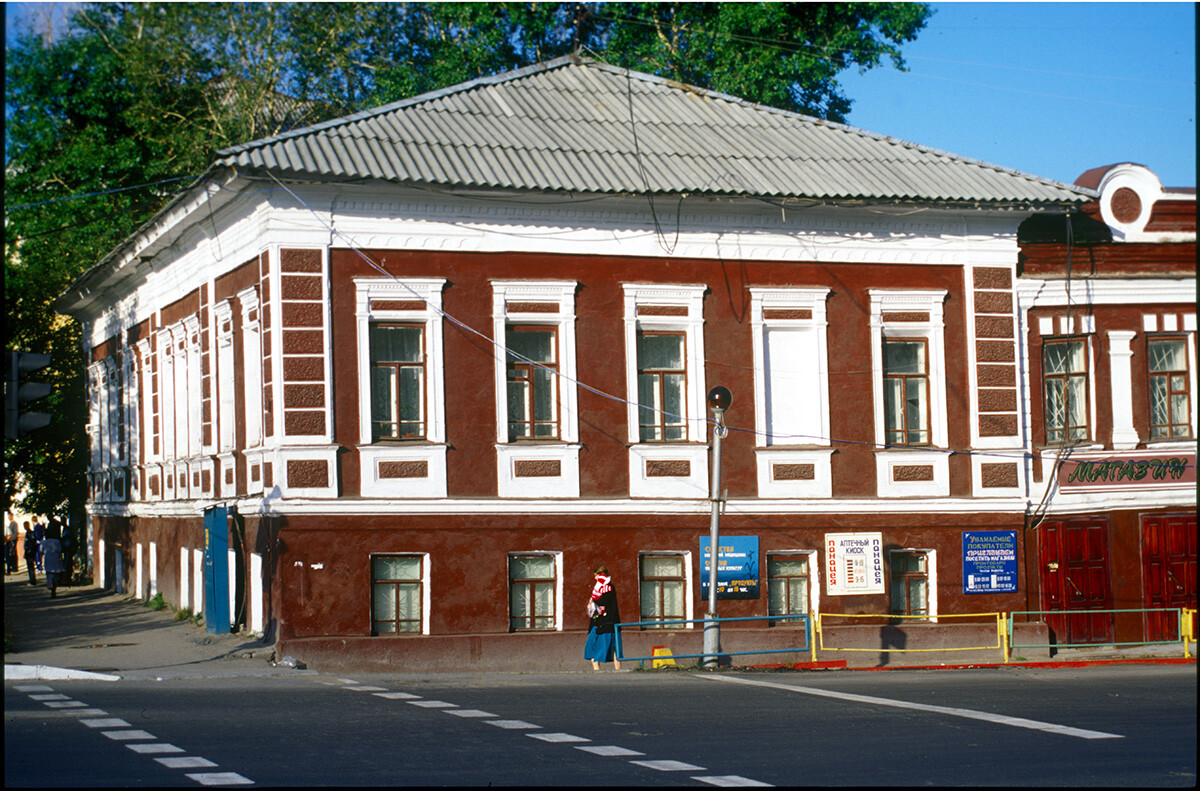
Ryazantsev house & store. August 12, 2000
William Brumfield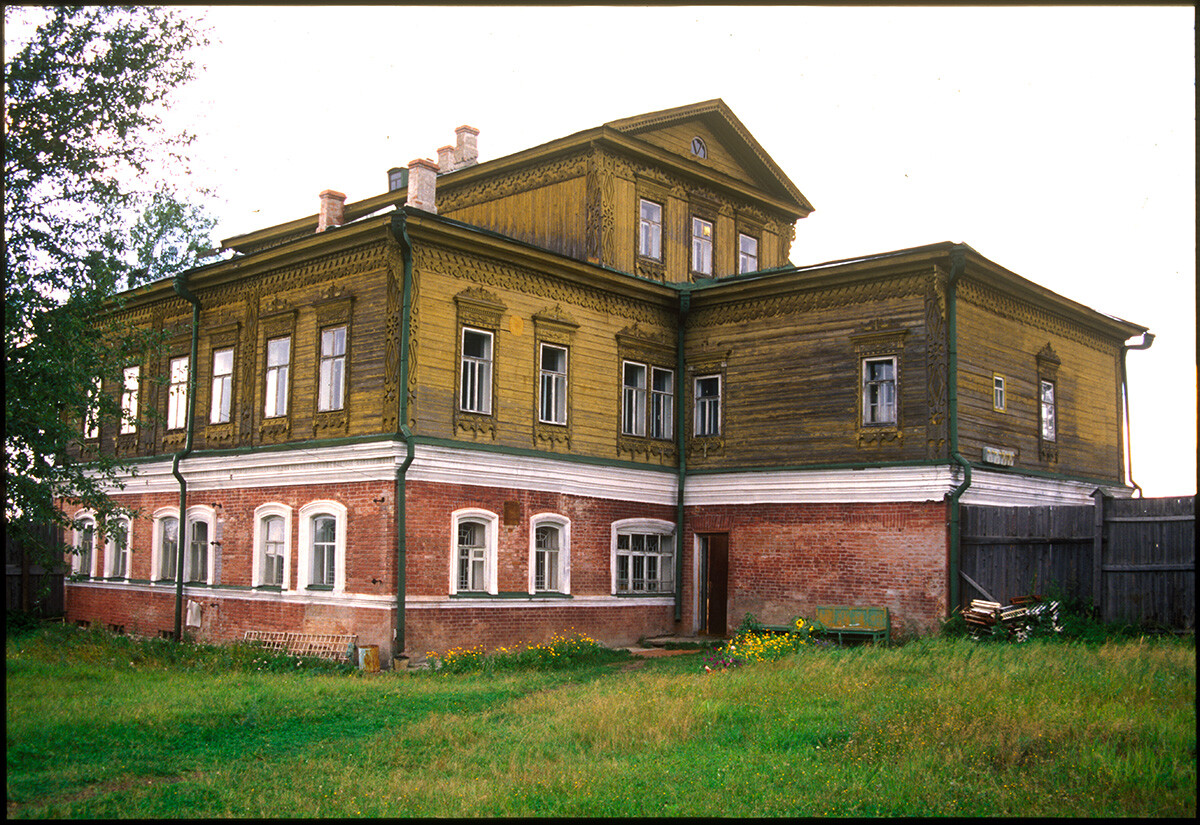
Ryazantsev Salt Works, Manager's house & office. August 12, 2000
William BrumfieldDuring the reign of Catherine the Great, the path of further mining and industrial development in the Urals shifted to the south, to the newer settlements of Perm and Ekaterinburg, which were served not by the Babinov Road, but by the newly opened Siberian Route.
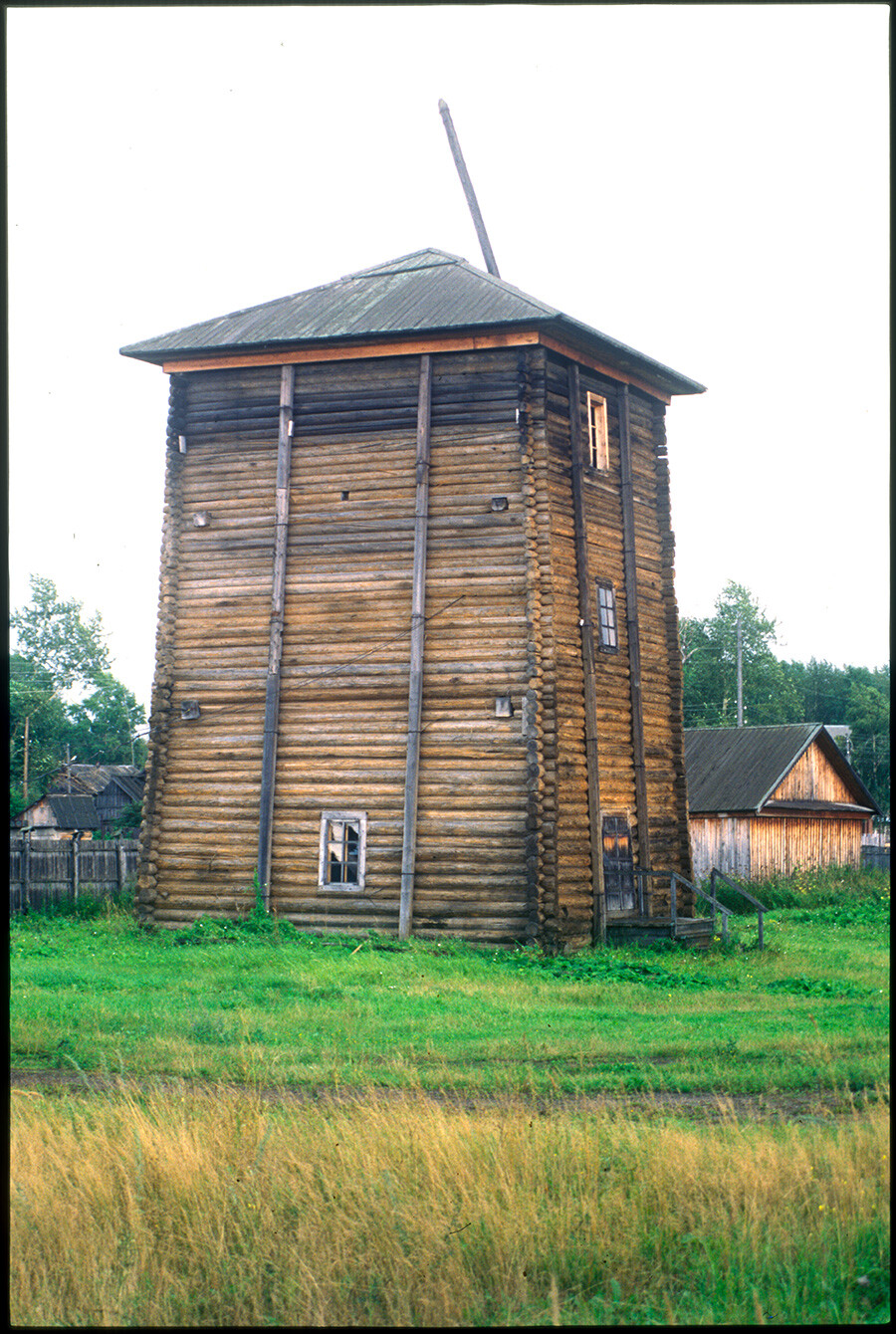
Ryazantsev Salt Works, Alexander brine pumping tower. August 12, 2000
William BrumfieldNonetheless, Solikamsk experienced modest growth in the latter part of the 19th century, a revival evident in several brick buildings whose design is typical of Russian provincial towns.

Ryazantsev Salt Works, salt bin. Right Resurrection brine pumping tower. August 12, 2000
William BrumfieldThe major reason for this positive turn was the renovation in the 1870s of local salt works under the ownership of the Ryazantsev family.
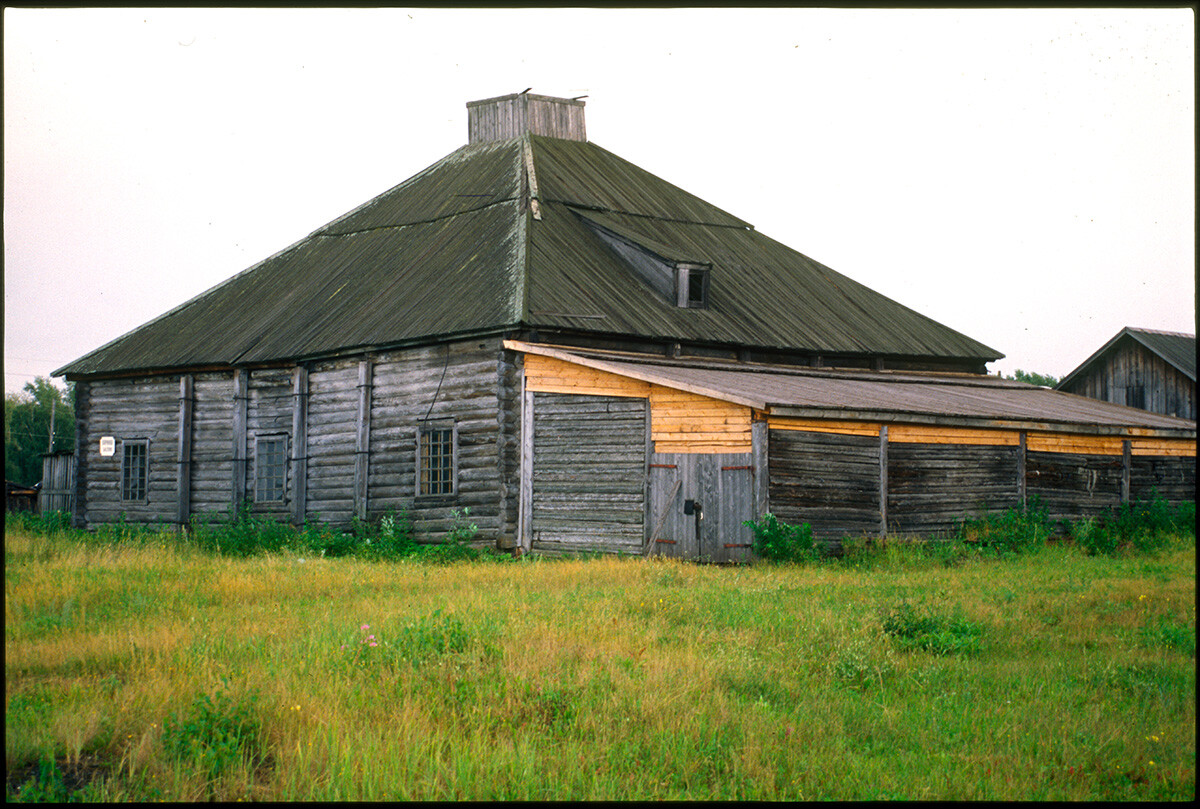
Ryazantsev Salt Works. Salt refinery building. August 12, 2000
William BrumfieldIndeed, salt continued to be produced at the former Ryazantsev works (under Soviet ownership) until 1972, and several of the massive 19th-century log buildings have survived - a rare example of log industrial structures on their original site.
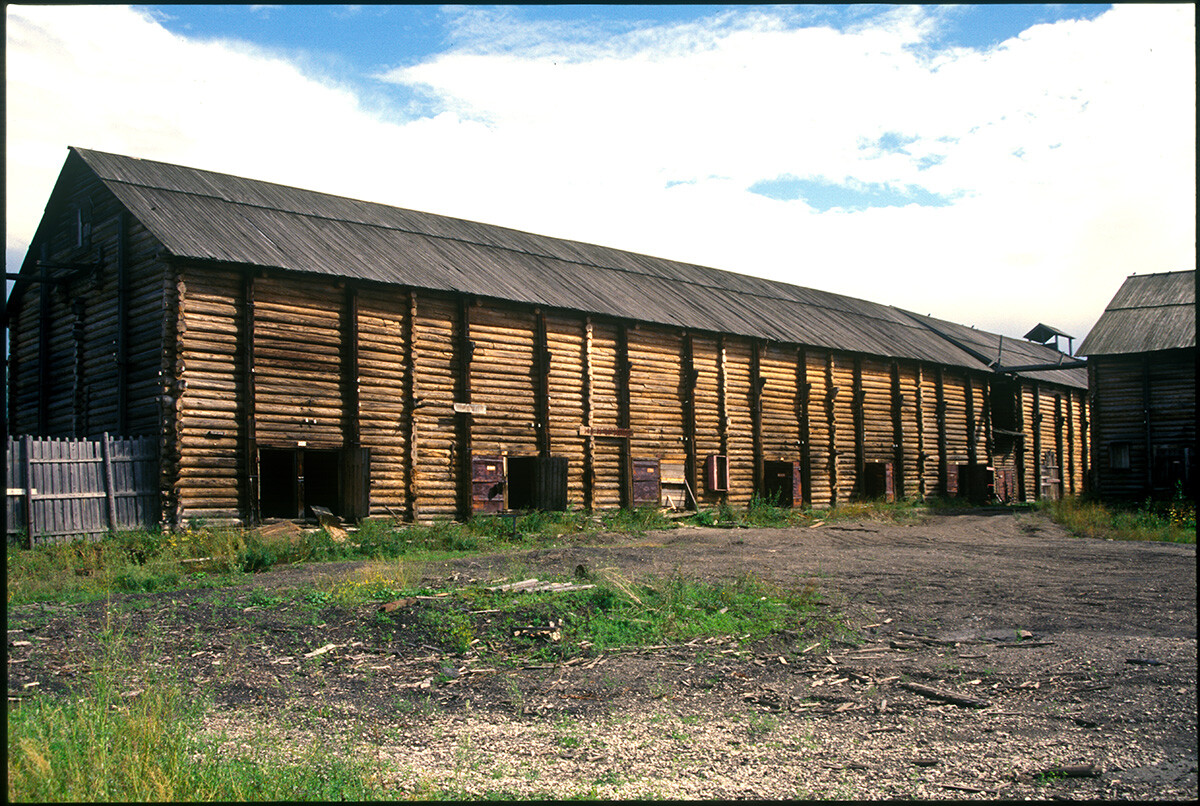
Ryazantsev Salt Works. Salt barn, Kama River facade. August 12, 2000
William Brumfield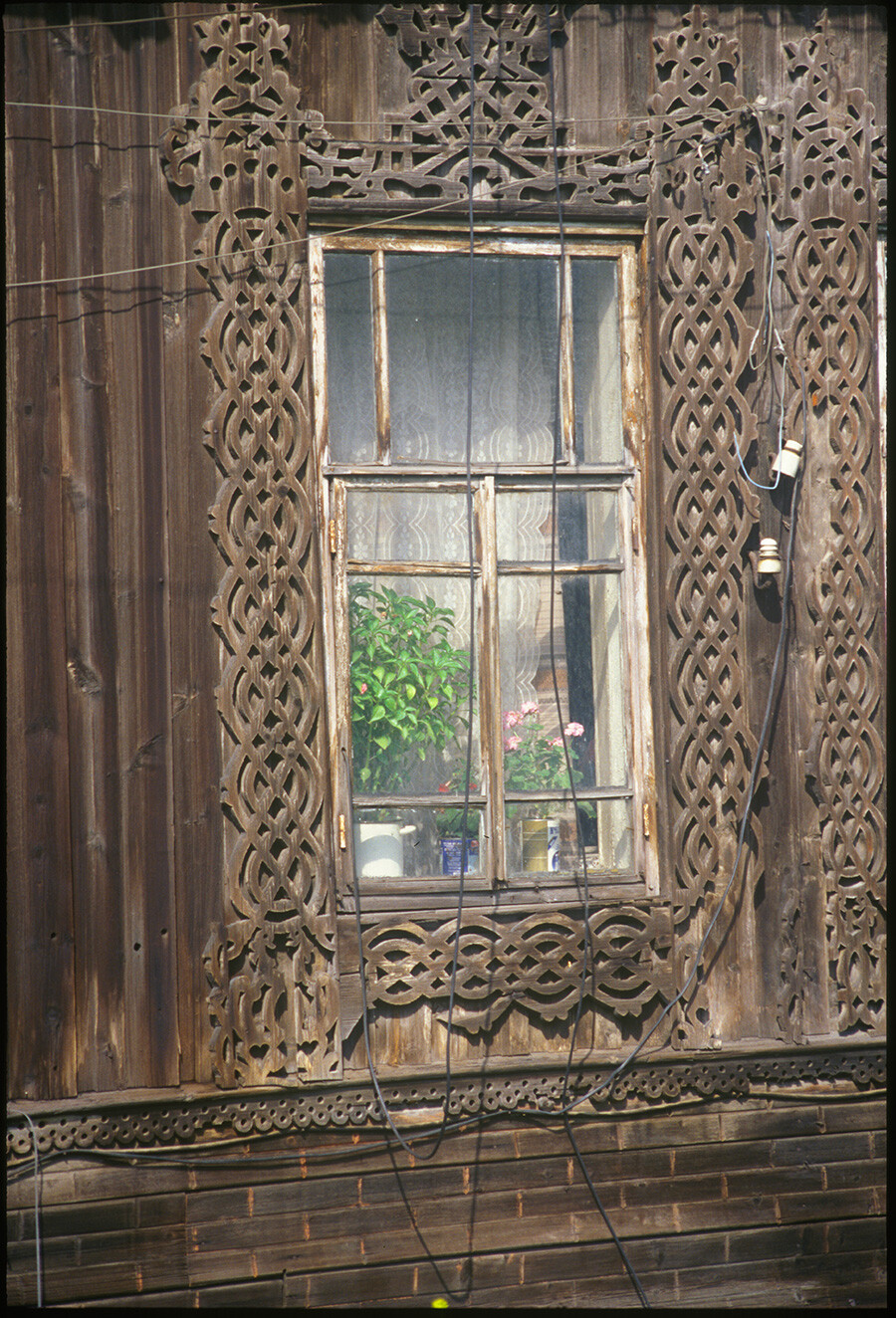
Decorative window frame of wooden house (late 19th century), May First Street. August 24, 1999
William BrumfieldIn the early 20th century, Russian photographer Sergey Prokudin-Gorsky developed a complex process for color photography. Between 1903 and 1916, he traveled through the Russian Empire and took over 2,000 photographs with the process, which involved three exposures on a glass plate. In August 1918, he left Russia and ultimately resettled in France where he was reunited with a large part of his collection of glass negatives, as well as 13 albums of contact prints. After his death in Paris in 1944, his heirs sold the collection to the Library of Congress. In the early 21st century, the Library digitized the Prokudin-Gorsky Collection and made it freely available to the global public. A few Russian websites now have versions of the collection. In 1986, architectural historian and photographer William Brumfield organized the first exhibit of Prokudin-Gorsky photographs at the Library of Congress. Over a period of work in Russia beginning in 1970, Brumfield has photographed most of the sites visited by Prokudin-Gorsky. This series of articles juxtaposes Prokudin-Gorsky’s views of architectural monuments with photographs taken by Brumfield decades later.
If using any of Russia Beyond's content, partly or in full, always provide an active hyperlink to the original material.
Subscribe
to our newsletter!
Get the week's best stories straight to your inbox